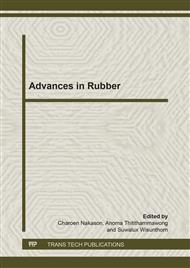p.3
p.7
p.11
p.15
p.20
p.24
p.30
p.34
Starch Synthesis and Mobilization in Wood and Bark of Rubber Tree, in Relation with Latex Production, (1) Methodological Approach
Abstract:
In rubber tree, starch reserves are necessary for growth and latex regeneration when the demand exceeds supply from photosynthesis. It tends to accumulate in the wood near the tapping cut [1,2] whereas sucrose remains rather stable in the wood and decreases in the latex vessels where it is used to regenerate the exported latex [3].Thus higher starch ability could sustain higher latex yield. However the enzymatic processes driving the dynamics of starch synthesis and hydrolysis as related to tapping are not known. The objective of the study is to analyze the effects of tapping on the enzymes involved in starch and sucrose metabolism in the wood of rubber trees. The first approach of this study was to set up the most adapted methodology on measurement of total nonstructural carbohydrates (NSC) and related enzymes activities. The experiment was conducted in Heveabrasiliensis (rubber tree), clone RRIM600. Treatments include untapped trees (Control) and yielding trees tapped with Ethephon stimulation (ET). Each treatment includes 6 trees. Samples have been collected along the trunk and separated into 2 parts, wood and bark, from both side of the tree tapped and untapped panel. The activity of acid invertase (AI), amylase (AMY), sucrose phosphate synthase (SPS) and sucrose synthase (SuSy) were assessed in the part of soft bark with amethod of sample preparation recoveringmore protein and concentrated enzyme with acetone precipitation. The method has increased enzyme activities of SuSy and SPS. On another hand, starch, sucrose, fructose and glucose concentrations have been enzymatically measured.The results showed that starch was the major component in wood and sucrose was mostly found in bark. There was no difference between the former drainage area and resting area after 2 untapped years before restarting tapping.
Info:
Periodical:
Pages:
15-19
Citation:
Online since:
November 2013
Price:
Сopyright:
© 2014 Trans Tech Publications Ltd. All Rights Reserved
Share:
Citation:


